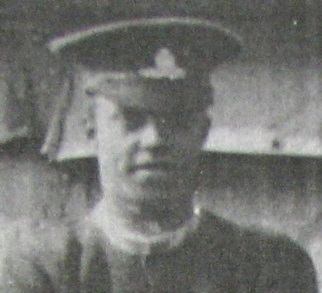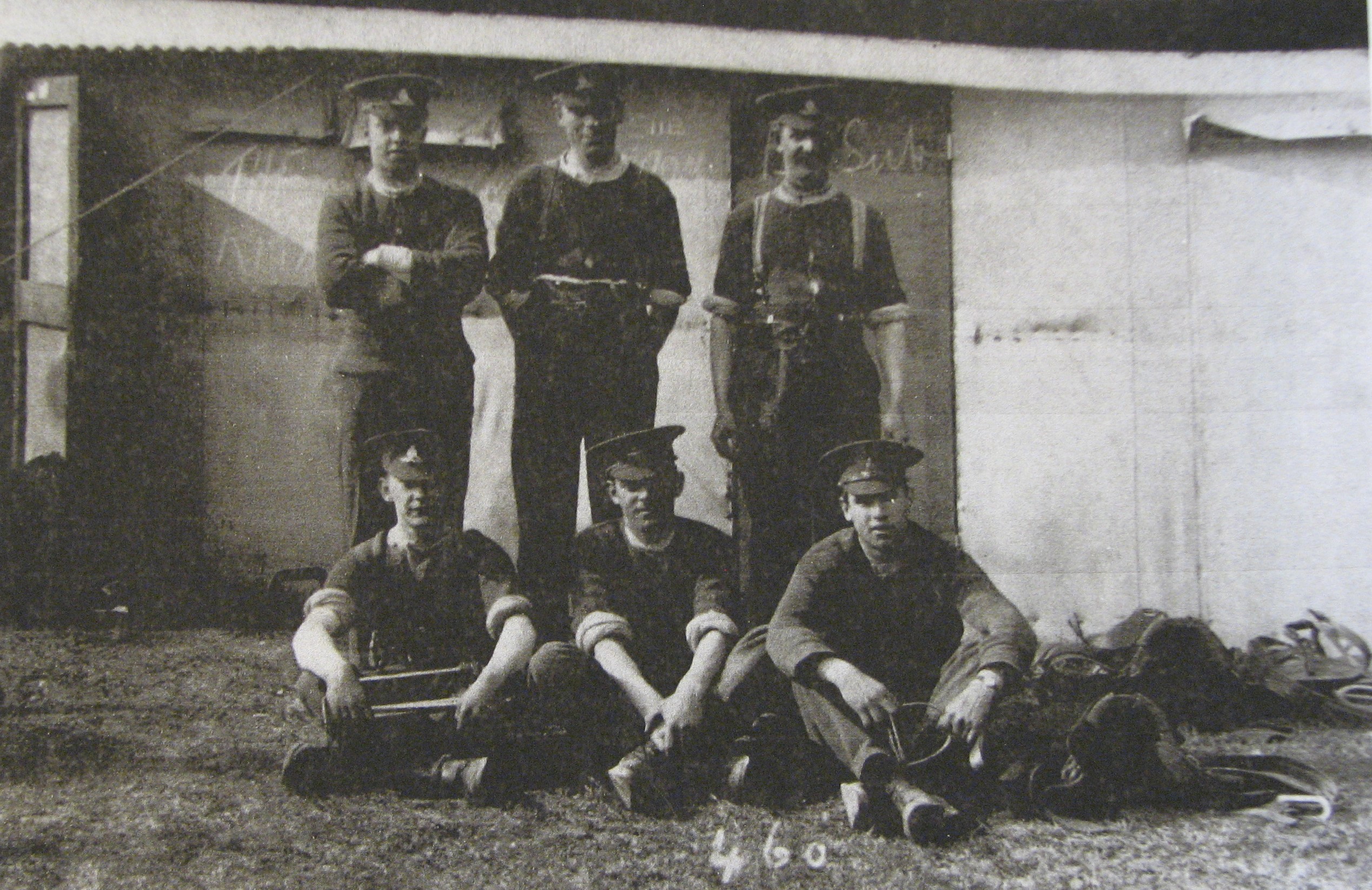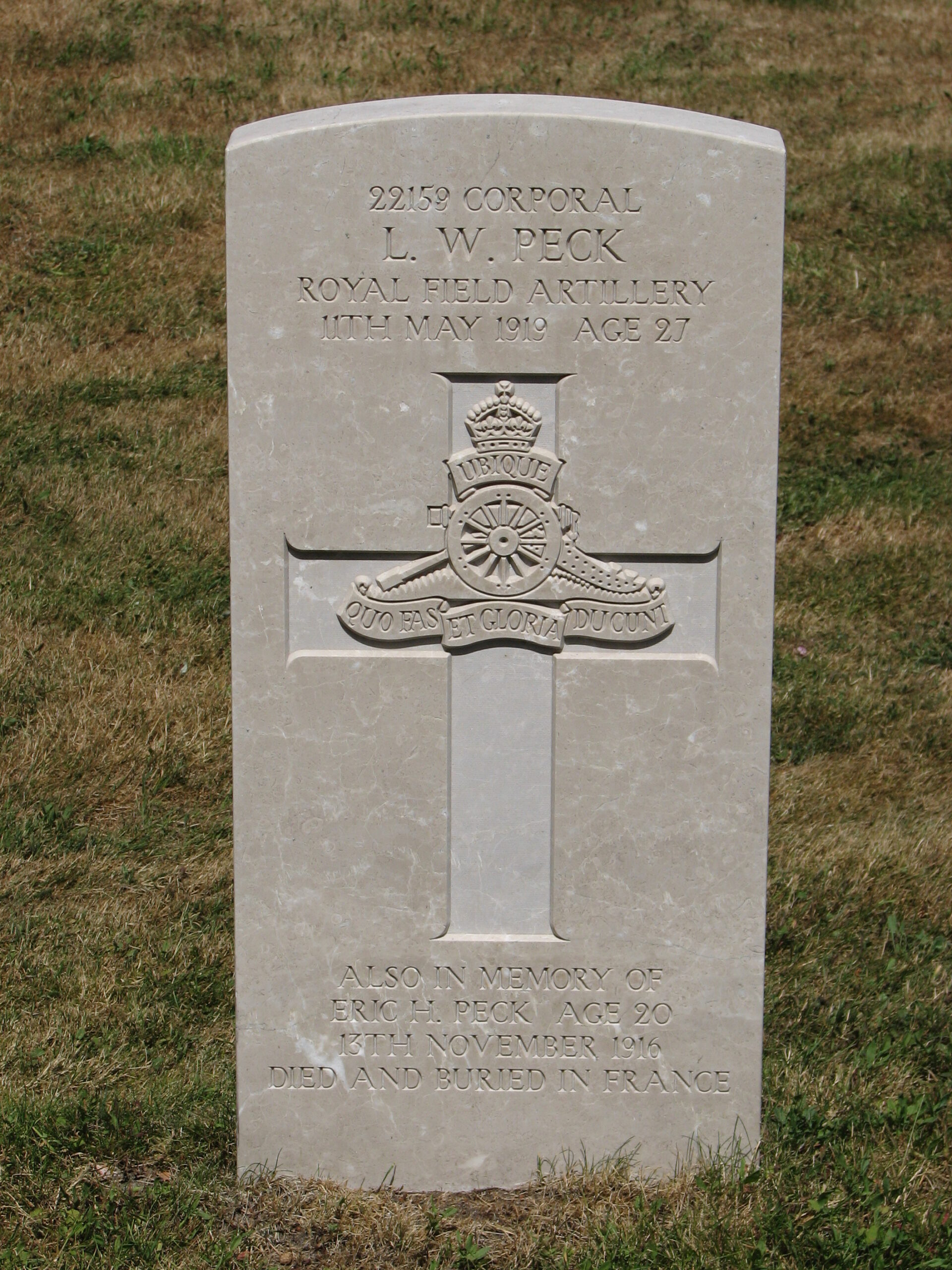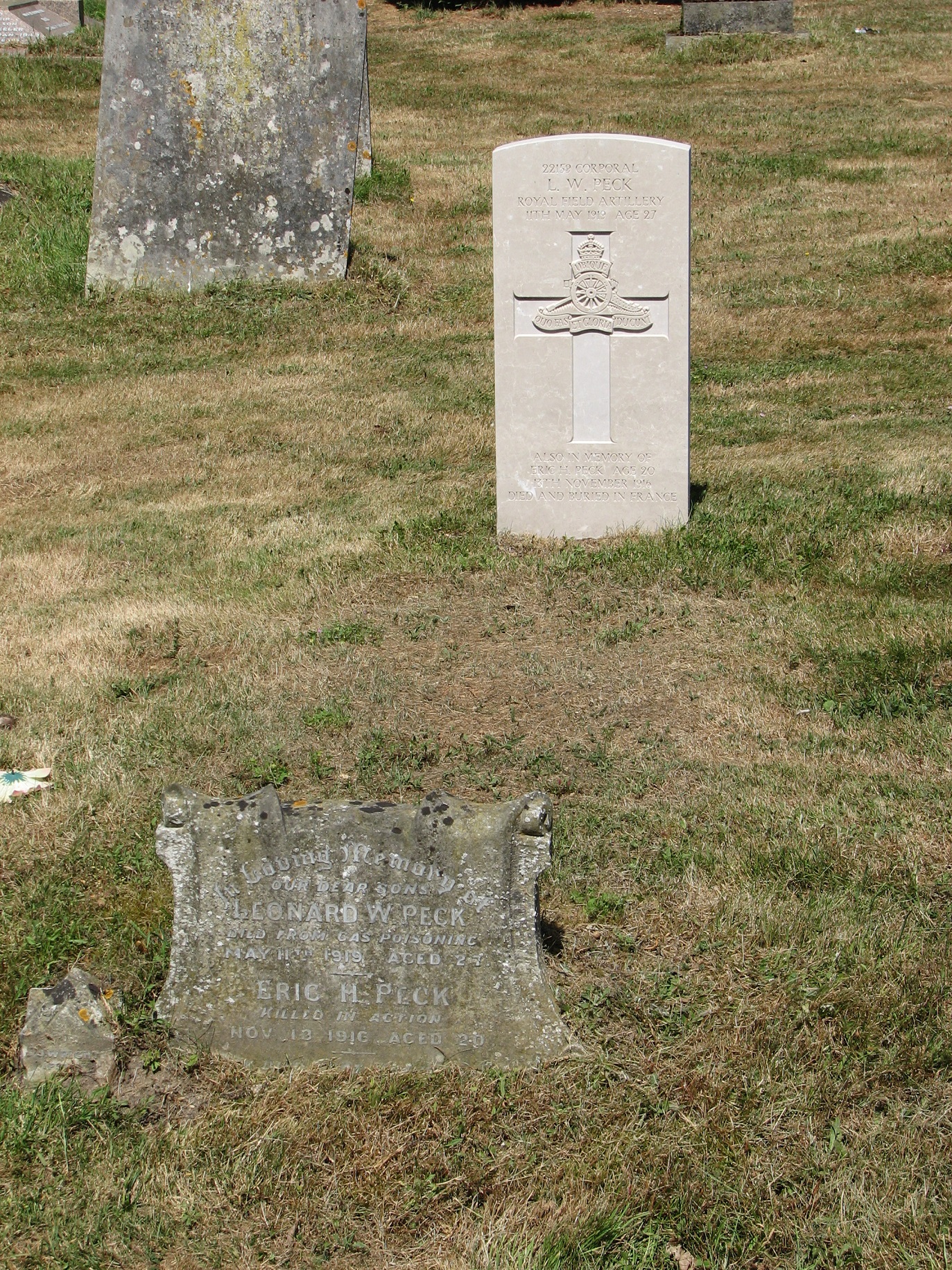Leonard Peck (1891 - 1919)
Brother of Eric Peck. Leonard volunteered to join the Army in September 1914 and served for over three years on the Western Front. Leonard was honourably discharged from the Army on medical grounds, as a result of being gassed.
- 54
- Died in the Great War
- 51.965411, 1.009562
Details
| Name: | Leonard Walter Peck |
| Service: | British Army |
| Unit: | “C” Battery, 82nd Brigade, Royal Field Artillery |
| Regimental Number: | 22159 |
| Rank: | Corporal |
| Date of Death: | 11th May 1919 |
| Age: | 27 |
| Buried: | East Bergholt Cemetery |
Family Background and Early Life
Leonard Walter Peck was born in East Bergholt on 25th September 1891, the firstborn child from the marriage of Walter and Jane Peck.
Walter was a Cattle Stockman, who was originally from Westhall, near Halesworth. He had married Jane Cheverton from Great Wenham, in 1890, and together they would have thirteen children, though three died in childhood.
By the April of 1901, the Pecks were living at Ackworth Lodge, though at some point in the next four years they moved to Woodgates Cottages.
After leaving school in 1904, Leonard found employment as a Bricklayers Labourer, though there is some evidence to suggest that he also received training as a plumber as well.
Joins the Army
On 9th September 1914, just over a month after the outbreak of war with Germany, Leonard along with George Tatum (who lived near the Hare and Hounds public house on Heath Road) travelled to Colchester. There, both Leonard and George volunteered to join the Royal Regiment of Artillery.
At the time he enlisted, Leonard was 5 foot 7 inches tall, weighed 140 pounds, and had a fresh complexion, brown eyes and brown hair.
Leonard and George were posted initially to 258 Battery of the Royal Field Artillery (RFA). 1 The Royal Field Artillery were the largest arm of the artillery during the Great War, and their role was to provide close artillery support for the infantry. They were mobile and deployed close to the front line and were responsible for the medium calibre guns and howitzers. Shortly afterwards 258 Battery was renamed C Battery, of the 82nd Brigade RFA, which was a part of the 18th (Eastern) Division. 2 The Brigade consisted of four batteries (A, B, C and D) each with four guns (later increased to six guns). A, B and C Batteries were equipped with the 18 pounder QF (Quick Firing) gun, the standard British field gun of that conflict. Each gun was pulled by a team of 6 horses.
A typical RFA battery consisted of 5 officers, 10 Sgts, 153 ORs, 6 guns (18 pounders or 4.5 inch howitzers), 6 ammunition wagons, 122 draught horses and 50 riding horses. A typical RFA brigade would be made up of 3 x 18 pounder batteries and 1 howitzer battery and was attached to a division. (Source- Great War Forum).
The 18th Division had originally been formed in September 1914, as part of Lord Kitchener’s “New Armies” which were the result of his call for volunteers following the outbreak of War. The Division was sent to France at the end of July 1915: Leonard, George and the other members of 82nd Brigade RFA sailed from Southampton and disembarked at the French port of Le Havre on the morning of the 25th of July.
France
The 82nd Brigade R.F.A. spent almost the entire war as a part of the 18th (Eastern) Division. However, there were occasions – normally when the 18th’s Infantry brigades were out of the front line – that the 82nd Brigade R.F.A., or one or more of its Batteries, were attached to another division on a temporary basis. 3 George Tatum was posted away from 82nd Brigade RFA in December 1915, and was part of the Expeditionary Force sent to Salonica. After George Tatum left the Army in 1919, he returned to East Bergholt and lived there until his death in 1980. George is buried in East Bergholt Cemetery.
By late August 1915 the 18th Division had taken over a part of the front south-west of the town Albert, on the Somme – the British having only recently taken over responsibility for this area from the French Army. At this time, the Somme sector was one of relative quiet, though by no stretch of the imagination did this mean that there was no fighting or casualties.
Battle of the Somme
The 18th Division would remain in the Somme sector for most of the next year, and on 1st July 1916 (the first day of the Battle of the Somme) it was one of the few British divisions to attain all of its objectives.
C Battery, along with the rest of the Brigade, had spent week prior to 1st July bombarding the German positions with shrapnel shells in an attempt to cut the barbed wire. The Brigade’s War Diary notes that during this bombardment “the average expenditure of Ammunition per Gun during operations was 220 rounds per day”. 4 Taken from the War Diary of 82 Brigade, Royal Field Artillery (National Archives Ref. WO 95/ 2024/ 3).
The Division suffered heavy losses during the Battle of the Somme, but amongst their notable successes were the capture of Trones Wood in July, and the capture of Thiepval village in September. 5 Colonel Sir Donald Banks K.C.B., D.S.O., M.C. wrote:
“It was for its actions during the Battles of the Somme in 1916, that the 18th (Eastern) Division started to gain a reputation as one of the most efficient divisions in the British Expeditionary Force (BEF). Rumour had it that the Germans rated it so highly as to place it first or second on their “danger list” of divisions after the Guards, and the 51st (Highland ) Division.”
Extract from the “The Essex Regiment – 9th, 10th, 11th, 13th and 15th Battalions (Essex Units in the War 1914 – 1919, Volume 6)” by John Wm. Burrows F.S.A., published by John Burrows and Sons, 1935.
In the November, Leonard’s parents were notified that his brother, Eric, who had been serving with 2 Battalion of the Suffolk Regiment, was Missing. It was to be another eight months, before the Army were able confirm to them that Eric had in fact been killed. 6 Eric Peck was killed in action during the Battle of the Somme on 13th November 1916, aged 20. He is buried in Luke Copse Cemetery, France.
Four more of Leonard’s brothers also served in the Army during the Great War:
Arthur survived the War. He served in the Machine Gun Corps and had been gassed.
Bertie survived the War, but had been wounded. He served with the Suffolk Regiment and later, the Royal Welsh Fusiliers.
Edmund survived the War. He served with the Manchester Regiment on the Western Front and was captured by the Germans in March 1918.
Cecil survived the War. He served with the Royal Fusiliers on the Western Front in 1918.
Awarded the Croix de Guerre (France)
The early part of 1917 saw the Division in action on the Ancre, and shortly afterwards it followed up the German Army during its withdrawal to the Hindenburg Line. It was during this period, that the Brigade’s Routine Orders of 22nd February 1917 announced that Leonard had been awarded the French Croix de Guerre medal.
Having spent more than a month out of the front line in billets, the Brigade returned to the front in early May during the Battle of Arras, taking part in the fighting near the village of Cherisy.
Third Battle of Ypres
C Battery and the remainder of 82 Brigade moved up to the Ypres Salient in July, where they were to support the Division in the forthcoming offensive, later called the Third Battle of Ypres. They were involved in the opening weeks of the offensive, with C Battery spending most of August in action around the village of Zillebeke.
At the end of the month, they marched to a rest area at Oudezeele where they went into Corps Reserve.
It was at Oudezeele on 3rd September 1917, that the Army Corps Commander, Lieutenant General Sir Claud Jacob inspected the 18th Divisional Artillery. The Brigade War Diary states that “He congratulated all ranks on the good work on the first phase of operations on the Ypres Salient from 31st July 1917 to 25th August 1917”. After the inspection Lieutenant General Jacob presented 13 Non Commission Officers and men with medal ribbons of awards – one of these men was Leonard, who was presented with the ribbon to his Croix de Guerre.
The Brigade went back into action in late September: They remained in the northern part of the Ypres Salient for the remainder of the Battle and then afterwards, until the end of January 1918. They finally left the Salient on 10th/ 11th February 1918, and were moved by train to billets located south-west of St. Quentin.
The German Spring Offensive
In early March 1918, the Brigade went back to the Front and moved into positions near the villages of Remigny and Mennessis, approximately 10 miles south of St. Quentin.
C Battery were at the Front when the full force of the massive German Spring Offensive was unleashed on a 43 mile front, in the early hours of 21st March 1918. Outnumbered, outgunned and in the face of new “shock” tactics, the already weakened British Line in that area soon gave way. Some British units were overwhelmed.
Over the next four days the 82nd RFA were forced to conduct a fighting retreat over approximately 13 miles, before they were eventually relieved by another Brigade. A and C batteries had suffered so heavily, that for a time the two were combined to form a composite battery.
The Brigade spent the next 4 months in and out of the line west of Amiens, sometimes alternating with units of the Australian Artillery. In early August, they moved to positions near the village of Morlancourt in the Somme sector, close to where they had first seen action in France three years before.
There, C Battery and the rest of the Brigade would provide some of the artillery support for a massive attack by the Fourth Army. The offensive started successfully and would mark the start of what would be called the “The 100 Days”, which culminated in Germany’s capitulation.
Gas
On 21st August 1918, whilst the Battery was still positioned near Morlancourt, Leonard was admitted to hospital suffering from Laryngitis. Ten days later, at the Number 13 Convalescent Department at Trouville, on the Channel Coast in Normandy, he was found to be suffering from Pleurisy with Effusion as a result of inhaling poison gas. When exactly this occurred is not recorded.
Leonard was so poorly that he was subsequently evacuated to England on 21st October and was sent to the 3rd Northern General Hospital in Sheffield.
The nature of Leonard’s injuries were such that on 17th January 1919 he was honourably discharged from the Army, under Paragragh 392, (xvi) of the King’s Regulations, being “No longer physically fit for war service.”
As a result of his injuries, Leonard was awarded a pension, which was to be reviewed after a year. He returned to East Bergholt live with his parents who by that time were living at Fen Bridge Cottage, at the foot of Fen Lane.
Leonard died at Fenbridge Cottage on 11th May 1919, of Bronchitis caused by him being gassed in France. He was laid to rest in East Bergholt Cemetery.
Postscript
Leonard’s parents remained in East Bergholt for the rest of their lives. Walter died in 1940 and Jane died in 1950. Both are buried in the village Cemetery.
Leonard’s grave was initially marked with a headstone paid for by his family. Subsequently – possibly as late as the 1990s – this was replaced by a standard Commonwealth War Graves Commission headstone. The original headstone was the moved to the foot of Leonard’s grave.
Copyright © Mark Ashmore, 2024
- 54
- Died in the Great War
- 51.965411, 1.009562




